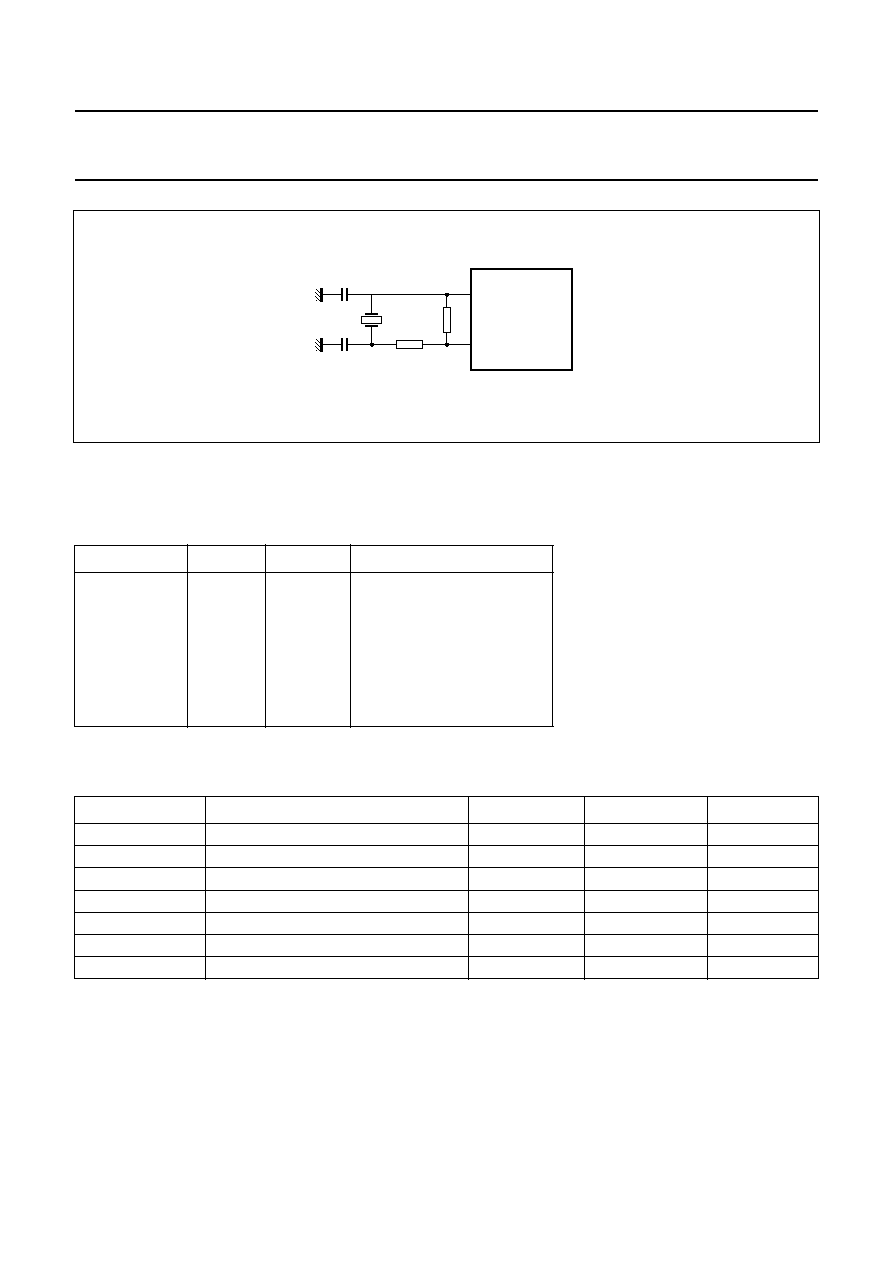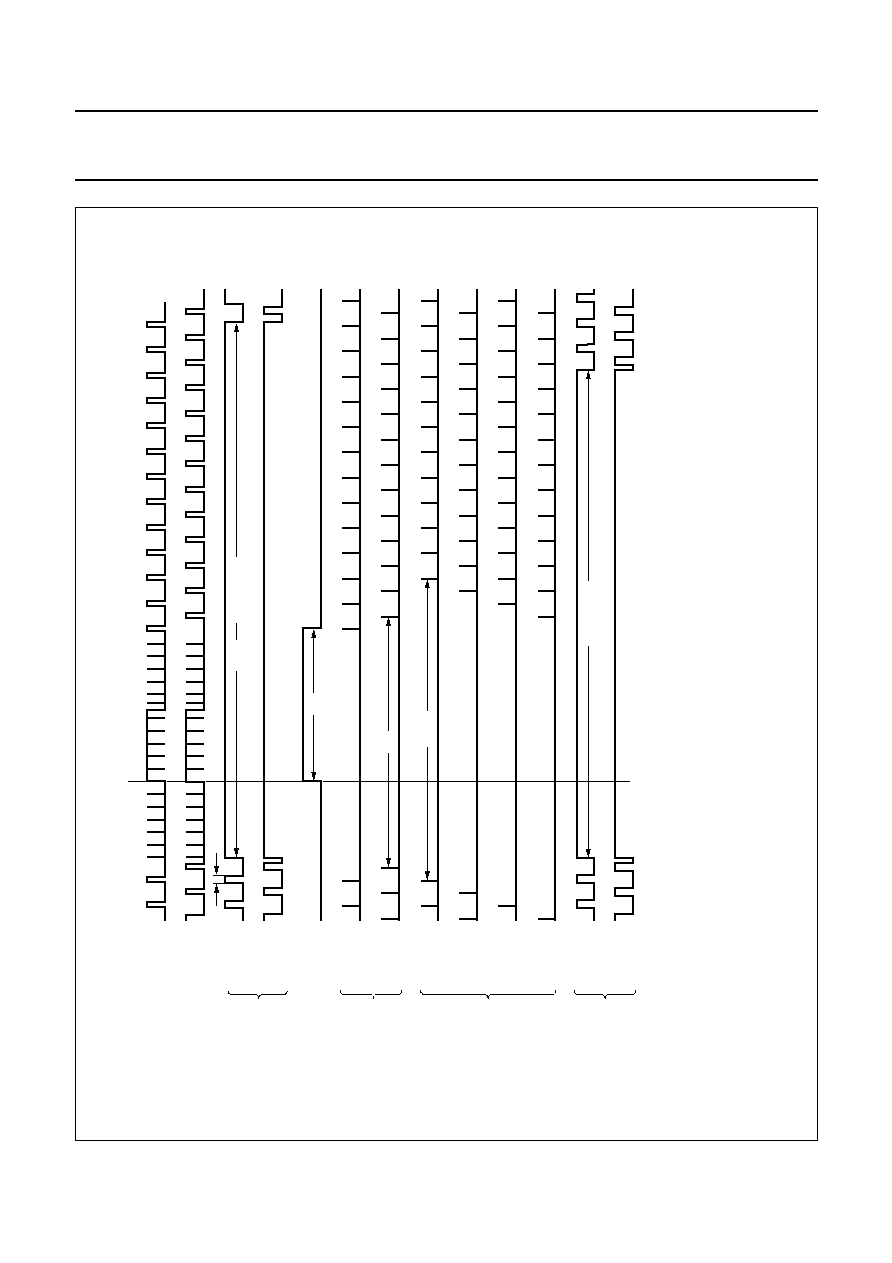 | –≠–ª–µ–∫—Ç—Ä–æ–Ω–Ω—ã–π –∫–æ–º–ø–æ–Ω–µ–Ω—Ç: SAA1101 | –°–∫–∞—á–∞—Ç—å:  PDF PDF  ZIP ZIP |

DATA SHEET
Product specification
File under Integrated Circuits, IC02
January 1990
INTEGRATED CIRCUITS
SAA1101
Universal sync generator (USG)

January 1990
2
Philips Semiconductors
Product specification
Universal sync generator (USG)
SAA1101
FEATURES
∑
Programmable to seven standards
∑
Additional outputs to simplify signal processing
∑
Can be synchronized to an external sync. signal
∑
Option to select the 524/624 line mode instead of the 525/625 line mode
∑
Lock from subcarrier to line frequency
GENERAL DESCRIPTION
The SAA1101 is a Universal Sync Generator (USG) and is designed for application in video sources such as cameras,
film scanners, video generators and associated apparatus. The circuit can be considered as a successor to the SAA1043
sync generator and the SAA1044 subcarrier coupling IC.
QUICK REFERENCE DATA
ORDERING AND PACKAGE INFORMATION
Notes
1. SOT117-1; 1996 December 02.
2. SOT136-1; 1996 December 02.
SYMBOL
PARAMETER
MIN.
MAX.
UNIT
V
DD
supply voltage range (pin 28)
4.5
5.5
V
I
DD
quiescent supply current
-
10
µ
A
f
OSC
clock oscillator frequency
-
24
MHz
EXTENDED
TYPE NUMBER
PACKAGE
PINS
PIN POSITION
MATERIAL
CODE
SAA1101P
28
DIL
plastic
SOT117
(1)
SAA1101T
28
SO28
plastic
SOT136A
(2)

January 1990
3
Philips Semiconductors
Product specification
Universal sync generator (USG)
SAA1101
k, full pagewidth
MGH191
COMBINING
LOGIC
VERTICAL
DIVIDER
RESET
PULSE
SHAPER
ADDITION/
SUPPRESSION
LOGIC
STANDARD
PROGRAMMED
DIVIDER
LINE
DIVIDER
HORIZONTAL
DETECTION
VERTICAL
DETECTION
VERTICAL
LOCK
SUBCARRIER
DIVIDER
SUBCARRIER
SUBTRACTION
LOCK MODE
SELECTION
PHASE
DETECTION
18
17
16
15
22
21
20
19
CS
CB
BK
ID
HD
VD
WMP
CLP
12
RR
7
VLE
11
ECS
f s
-
f
f s
f
f H
H
ref
40f
H
HRI
f H
2f
H
160f
H
PRESCALER
SAA1101
8
14
28
91
0
PH
LM1
LM0
NORM
SI
13
23
24
3
4
CS1
CLO
CS0
V
SS
V
DD
X
Y
Z
FSO
FSI
OSCO
OSCI
25
26
27
2
1
6
5
Fig.1 Block diagram.

January 1990
4
Philips Semiconductors
Product specification
Universal sync generator (USG)
SAA1101
FUNCTIONAL DESCRIPTION
Generation of pulses
Generation of standard pulses such
as sync, blanking and burst for TV
systems: PAL B/G, PALN, PALM,
SECAM and NTSC. In addition a
number of non-standard pulses have
been supplied to simplify signal
processing. These signals include -
horizontal drive, vertical drive, clamp
pulse, identification etc. It is possible
to select the 524/624 line mode
instead of the 525/625 line mode for
all the above TV systems for
applications such as robotics, games
and computers.
Fig.2
Pinning configuration;
SOT117.
fpage
FSI
FSO
CS1
CS0
OSCI
OSCO
VLE
PH
LM1
LM0
ECS
RR
SI
VSS
VDD
Z
Y
X
NORM
HD
CLO
VD
WMP
CLP
CS
CB
BK
ID
1
2
3
4
5
6
7
8
9
10
11
12
13
28
27
26
25
24
23
22
21
20
19
18
17
16
15
14
SAA1101
MGH190
PINNING
SYMBOL
PIN
DESCRIPTION
FSI
1
subcarrier oscillator input, where f
max
= 5 MHz
FSO
2
subcarrier oscillator output
CS1
3
clock frequency selection - CMOS input
CS0
4
clock frequency selection - CMOS input
OSCI
5
clock oscillator input, where f
max
= 24 MHz
OSCO
6
clock oscillator output
VLE
7
vertical in-lock enable - CMOS input
PH
8
phase detector output - 3-state output
LM1
9
lock mode selection - CMOS input
LM0
10
lock mode selection - CMOS input
ECS
11
external composite sync. signal - CMOS Schmitt-trigger
input
RR
12
frame reset - CMOS Schmitt-trigger input
SI
13
set identification, used to set the correct field sequence in
PAL-mode. The correction (inversion of fH2) is done at the
left-hand slope of the SI-pulse. Minimum pulse width is
800 ns. CMOS Schmitt-trigger input.
V
SS
14
ground
ID
15
identification - push-pull output
BK
16
burst key (PAL/NTSC), chroma-blanking (SECAM) -
push-pull output
CB
17
composite blanking - push-pull output
CS
18
composite sync. - push-pull output
CLP
19
clamp pulse - push-pull output
WMP
20
white measurement pulse-3-state output
VD
21
vertical drive pulse - push-pull output
HD
22
horizontal drive pulse - push-pull output
NORM
23
used with X, Y and Z to select TV system; NORM = 0,
625/525 line mode (standard);
NORM = 1, 624/524 line mode - CMOS input
CLO
24
clock output - push-pull output
X
25
TV system selection input - CMOS input
Y
26
TV system selection input - CMOS input
Z
27
TV system selection input - CMOS input
V
DD
28
voltage supply

January 1990
5
Philips Semiconductors
Product specification
Universal sync generator (USG)
SAA1101
Lock modes
The USG offers four lock modes:
∑
Lock from the subcarrier
∑
Slow sync. lock, external H
ref
∑
Slow sync. lock, internal H
ref
∑
Fast sync. lock, internal H
ref
LOCK FROM SUBCARRIER
Lock from subcarrier to the line frequency for the above
mentioned TV systems is given below; the horizontal
frequency (f
H
) = 15.625 kHz for 625 line systems and
15.734264 kHz for 525 line systems.
These relationships are obtained by the use of a phase
locked loop and the internal programmed divider chain,
see Fig.3(a).
LOCK TO AN EXTERNAL SIGNAL SOURCE
The following methods can be used to lock to an external
signal source:
1. Sync. lock slow; the line frequency is locked to an
external signal. The line and frame information are
extracted from the external sync. signal and used
separately in the lock system. The line information is
used in a phase-locked loop where external and
internal line frequencies are compared by the same
phase detector as is used for the subcarrier lock. The
external frame information is compared with the
internal frame in a slow lock system; mismatch of
internal and external frames will result in the addition
or suppression of one line depending on the direction
of the fault. The maximum lock time for frame lock is
6.25 s, see Fig.3(b).
2. Sync. lock fast. A fast lock of frames is possible with a
frame reset which is extracted out of the incoming
external sync. signal, see Fig.3(c).
3. Sync. lock with external reference. Lock of an external
sync. signal to the line frequency with an external line
reference to make possible a shifted lock. The
SECAM (1 and 2)
282f
H
PALN
229.2516f
H
NTSC (1 and 2)
227.5f
H
PALM
227.25f
H
PAL B/G
283.7516f
H
subcarrier input is, in this case, used as an external
input for the horizontal reference, see Fig.3(d).
SELECTION OF LOCK MODE
Lock mode is selected using the inputs LM0 and LM1 as
illustrated in the Table below.
LM0
LM1
SELECTION
0
0
lock to subcarrier
0
1
slow sync. lock external H
ref
1
0
slow sync. lock internal H
ref
1
1
fast sync. lock internal H
ref

January 1990
6
Philips Semiconductors
Product specification
Universal sync generator (USG)
SAA1101
The different lock modes are illustrated by the following figures:
Fig.3 (a) Lock to subcarrier.
Fig.3 (b) Slow sync lock, internal H
ref
Fig.3 (c) Fast sync lock, internal H
ref
Fig.3 (d) Slow sync lock, external H
ref
handbook, halfpage
MGH193
n
◊
fH
LINE
OSCILLATOR
FSO
FSI
OSCO
OSCI
SAA1101
SUB-
CARRIER
OSCILLATOR
PH
LM1
LM0
logic 0
logic 1
10
6
5
8
2
1
9
handbook, halfpage
MGH194
n
◊
fH
LINE
OSCILLATOR
ECS
OSCO
OSCI
SAA1101
PH
LM1
LM0
logic 0
logic 1
10
6
5
8
11
9
handbook, halfpage
MGH195
n
◊
fH
LINE
OSCILLATOR
ECS
OSCO
OSCI
SAA1101
PH
LM1
LM0
logic 1
logic 1
10
6
5
8
11
9
handbook, halfpage
MGH192
n
◊
fH
LINE
OSCILLATOR
Href
ECS
FSI
HD
OSCO
OSCI
SAA1101
PH
LM1
LM0
logic 0
logic 1
10
6
5
8
22
11
1
9

January 1990
7
Philips Semiconductors
Product specification
Universal sync generator (USG)
SAA1101
LOCK WITH HORIZONTAL AND VERTICAL SIGNALS
(slow lock modes only)
It is possible to use horizontal and vertical signals instead of composite sync signals. The connections in this situation
are: the external horizontal signal is connected to the ECS input (pin 11) and the vertical signal to the RR input (pin 12).
The HIGH time of the horizontal pulse must be less than 14.4
µ
s, otherwise it will be detected as being a vertical pulse
and will corrupt the vertical slow lock system.
Selection of Clock Frequency
The clock frequency is selected using the CS0 and CS1 inputs as illustrated below.
Where the horizontal frequency, f
H
= 15.625 kHz for 625 lines and 15.734264 kHz for 525 lines.
Oscillators
The subcarrier oscillator has FSI as its input and FSO as its output. It is always used as a crystal oscillator with a series
resonance crystal with parallel load capacitor. The maximum frequency, f
max
= 5 MHz and the load capacitor,
C
L
= 10
<
C
L
<
35 pF.
The clock oscillator has OSCI as its input and OSCO as its output. It can be used with an LC oscillator or a series
resonance crystal with parallel load capacitor (Fig.4). The maximum frequency, f
max
= 24 MHz and the load capacitor,
C
L
= 10
<
C
L
<
35 pF.
Selection of 625/525 (standard; interlaced mode) or 624/524 lines (non-interlaced mode)
Selection is achieved using the NORM input. When NORM = 0, 625/525 (standard) lines are selected;
when NORM = 1, 624/524 line are selected.
Output Dimensions
All push-pull outputs: standard output 2 mA.
White measurement pulse, WMP: 3-state output 2 mA.
Phase detector, PH: 3-state output 2 mA.
CS0
CS1
FREQUENCY
625 LINES
525 LINES
UNITS
0
0
160f
H
2.5
2.517482
MHz
0
1
160f
H
5
5.034964
MHz
1
0
960f
H
15
15.104893
MHz
1
1
1440f
H
22.5
22.657340
MHz

January 1990
8
Philips Semiconductors
Product specification
Universal sync generator (USG)
SAA1101
Selection of TV System
Selection of the required TV system is achieved by the X, Y and Z inputs as illustrated by the following Table.
LIMITING VALUES
Limiting values in accordance with the Absolute Maximum System (IEC 134)
Note
1. Input voltage should not exceed 7 V.
SYSTEM
X
Y
Z
SECAM1
0
0
0
PALN
0
0
1
NTSC1
0
1
0
PALM
0
1
1
SECAM2
1
0
0 (with identifier)
PAL B/G
1
0
1
NTSC2
1
1
0 (short blanking)
SYMBOL
PARAMETER
MIN.
MAX.
UNIT
V
DD
supply voltage
-
0.5
+
7
V
V
I
input voltage
-
0.5
V
DD
+
0.5
(1)
V
I
I
maximum input current
-
±
10
mA
I
O
maximum output current
-
±
10
mA
I
DD
maximum supply current in V
DD
-
25
mA
P
tot
maximum power dissipation
-
400
mW
T
stg
storage temperature range
-
55
+
150
∞
C
Fig.4 Crystal oscillator circuit.
handbook, halfpage
MGH196
SAA1101
6
5
500 k
1 k
39 pF
39 pF
15 MHz
OSCI
OSCO

January 1990
9
Philips Semiconductors
Product specification
Universal sync generator (USG)
SAA1101
CHARACTERISTICS
V
DD
= 4.5 to 5.5 V; T
amb
=
-
25 to
+
70
∞
C unless otherwise specified
SYMBOL
PARAMETER
CONDITIONS
MIN.
TYP.
MAX.
UNIT
Supplies
V
DD
supply voltage
4.5
-
5.5
V
I
DD
supply current (quiescent)
T
amb
= 25
∞
C
-
-
10
µ
A
Inputs
±
I
I
input leakage current
T
amb
= 25
∞
C
-
-
100
nA
CMOS COMPATIBLE; X, Y, Z, NORM, CS0, CS1, LM0, LM1 AND VLE
V
IH
input voltage HIGH
0.7V
DD
-
-
V
V
IL
input voltage LOW
-
-
0.3V
DD
V
SCHMITT TRIGGER INPUTS; ECS, RR AND SI
V
T
+
positive-going threshold
-
2.5
4
V
V
T
-
negative-going threshold
1
1.5
-
V
V
H
hysteresis
0.4
1
-
V
OSCILLATOR INPUTS; OSCI AND FSI
V
IH
input voltage HIGH
0.7V
DD
-
-
V
V
IL
input voltage LOW
-
-
0.3V
DD
V
Outputs
PUSH-PULL OUTPUTS; CB, CS, BK, ID, HD, VD, CLP AND CLO
V
OH
output voltage HIGH
-
I
O
= 2 mA; V
DD
= 5 V
4.5
-
-
V
V
OL
output voltage LOW
I
O
= 2 mA; V
DD
= 5 V
-
-
0.5
V
OSCILLATOR OUTPUTS; OSCO AND FSO
V
OH
output voltage HIGH
-
I
O
= 0.75 mA; V
DD
= 5 V
4.5
-
-
V
V
OL
output voltage LOW
I
O
= 0.75 mA; V
DD
= 5 V
-
-
0.5
V
3-STATE OUTPUTS; WMP AND PH
V
OH
output voltage HIGH
-
I
O
= 2 mA; V
DD
= 5V
4.5
-
-
V
V
OL
output voltage LOW
I
O
= 2 mA; V
DD
= 5V
-
-
0.5
V
±
I
OZ
OFF-state current
T
amb
= 25
∞
C
-
-
50
nA

January 1990
10
Philips Semiconductors
Product specification
Universal sync generator (USG)
SAA1101
OUTPUT WAVEFORMS
The output waveforms for the different modes of operation are illustrated by Figs 5 and 6.
25H
+
t
WCB
full pagewidth
MGH198
1st half
picture
2nd half
picture
1st half
picture
2nd half
picture
1st half
picture
2nd half
picture
3rd half
picture
4th half
picture
1st half
picture
2nd half
picture
1st half
picture
2nd half
picture
ID
ID
BK
BK
BK
BK
SECAM
-
1
CCIR/P
AL
BK
BK
CB
CB
VD
CS
CS
9H
(1)
10H
t WCB
start half picture
(1) H = 1 horizontal scan.
Fig.5
Typical output waveforms for PAL/CCIR and SECAM. In the 624-line mode the output waveforms are identical to the first half
picture of PAL/CCIR and are not interlaced.

January
1990
11
Philips Semiconductors
Product specification
Universal sync generator (USG)
SAA1
101
21H
+
tWCB
u
ll pagewidth
MGH197
1st half
picture
2nd half
picture
1st half
picture
2nd half
picture
1st half
picture
2nd half
picture
1st half
picture
2nd half
picture
3rd half
picture
4th half
picture
1st half
picture
2nd half
picture
CB
CB
NTSC 2
(2
)
BK
BK
BK
BK
PAL
-
M
BK
BK
NTSC 1
+
2
(2)
CB
CB
VD
NTSC 1
(2)
CS
CS
19H
+
tWCB
9H
6H
tWCB
start half picture
11H
(1)
(1) H = 1 horizontal scan.
(2) NTSC mode reset; the fourth half picture is identical to the second half picture for NTSC.
Fig.6
Typical output waveforms for NTSC and PAL-M. In the 524-line mode the output waveforms are identical to the first half picture of NTSC
and are not interlaced.

January 1990
12
Philips Semiconductors
Product specification
Universal sync generator (USG)
SAA1101
WAVEFORM TIMING
The waveform timing depends on the frequency of the oscillator input (f
OSCI
). This is illustrated in the table below as the
number (N) of oscillations at OSCI. The timings are derived from N
◊
t
OSCI
±
100 ns.
One horizontal scan (H) = 320
◊
t
OSCI
=1/f
H
.
Where t
OSCI
= 200 ns for PAL/SECAM and 198.6 ns for NTSC/PAL-M
SYMBOL
PARAMETER
PAL
NTSC
PAL-M
SECAM
UNIT
N
Composite sync (CS)
t
WSC1
horizontal sync pulse
width
4.8
4.77
4.77
4.8
µ
s
24
t
WSC2
equalizing pulse width 2.4
2.38
2.38
2.4
µ
s
12
t
WSC3
serration pulse width
4.8
4.77
4.77
4.8
µ
s
24
-
duration of
pre-equalizing pulses
2.5
3
3
2.5
H
-
-
duration of
post-equalizing
pulses
2.5
3
3
2.5
H
-
-
duration of serration
pulses
2.5
3
3.5
2.5
H
-
Composite blanking (CB)
HORIZONTAL BLANKING PULSE WIDTH
t
WCB
PAL/SECAM/PAL-M
12
-
11.12
12
µ
s
60
t
WCB
NTSC1
-
11.12
-
-
µ
s
56
t
WCB
NTSC2
-
10.53 (note1)
-
-
µ
s
53
FRONT PORCH
t
PCBCS
front porch
1.6
1.59
1.59
1.6
µ
s
8
DURATION OF VERTICAL BLANKING
-
PAL/SECAM/PAL-M
25H
+
t
WCB
-
21H
+
t
WCB
25H
+
t
WCB
-
-
-
NTSC1
-
21H
+
t
WCB
-
-
-
-
-
NTSC2
-
19H
+
t
WCB
-
-
-
-
Burst key (BK) (not SECAM)
t
WBK
burst key pulse width
2.4
2.38
2.38
-
µ
s
12
t
PCSBK
CS to burst key delay
5.6
5.56
5.76
-
µ
s
28
-
burst suppression
9
9
11
-
H
-
POSITION OF BURST SUPPRESSION
-
first half picture
H623 to H6
H523 to H6
H523 to H8
-
-
-
-
second half picture
H310 to H318
H261 to H269
H260 to H270
-
-
-
-
third half picture
H622 to H5
H523 to H6
H522 to H7
-
-
-
-
fourth half picture
H311 to H319
H261 to H269
H259 to H269
-
-
-

January 1990
13
Philips Semiconductors
Product specification
Universal sync generator (USG)
SAA1101
Notes to the characteristics
1. Horizontal blanking pulse width for NTSC2 can be 11.12
µ
s maximum
2. SECAM1, first half picture: 25H
+
t
WBK
except H320 to H328. Second half picture: 24.5H
+
t
WBK
except H7 to H15.
3. SECAM2, first half picture: 25H
+
t
WBK
. Second half picture: 24.5H
+
t
WBK
.
Burst key (BK) (SECAM)
t
WBK
chroma pulse width
-
-
-
7.2
µ
s
36
t
PBKCS
CS to chroma delay
-
-
-
1.6
µ
s
8
DURATION OF VERTICAL BLANKING
-
SECAM1
-
-
-
note 2
-
-
-
SECAM2
-
-
-
note 3
-
-
Clamp pulse (CLP)
t
WCLP
clamp pulse width
2.4
2.38
2.38
2.4
µ
s
12
t
PCSCLP
CS to CLP delay
1.6
1.59
1.59
1.6
µ
s
8
Horizontal drive (HD)
t
WHD
pulse width
7.2
7.15
7.15
7.2
µ
s
36
t
PHDCS
CS to HD delay
0.8
0.79
0.79
0.8
µ
s
4
-
repetition period
64
63.56
63.56
64
µ
s
-
Vertical drive (VD)
-
VD duration
10
6
6
10
H
-
t
PVDCS
CS to VD delay
1.6
1.59
1.59
1.6
µ
s
8
White measurement pulse (WMP)
-
pulse width
2.4
2.38
2.38
2.4
µ
s
12
-
CS to WMP delay
34.4
34.16
34.16
34.4
µ
s
172
-
duration of WMP
10
9
9
10
H
-
POSITION OF WMP
-
first half picture
H163 to H173
H134 to H143
H134 to H143
H163 to H173
-
-
-
second half picture
H475 to H485
H396 to H405
H396 to H405
H475 to H485
-
-
Identification (ID)
t
WID
pulse width
12
11.12
11.12
12
µ
s
60
t
PIDCS
CS to ID delay
1.6
1.59
1.59
1.6
µ
s
8
POSITION OF ID
-
first half picture
H7 to H15
H8 to H22
H8 to H22
H7 to H15
-
-
-
second half picture
H320 to H328
H271 to H285
H271 to H285
H320 to H328
-
-
SYMBOL
PARAMETER
PAL
NTSC
PAL-M
SECAM
UNIT
N

January 1990
14
Philips Semiconductors
Product specification
Universal sync generator (USG)
SAA1101
Fig.7 Waveform timing.
handbook, full pagewidth
horizontal
sync pulse
equalizing pulse
serration pulse
horizontal
blanking pulse
burst key (PAL)
(SECAM)
chrominance
blanking
horizontal drive
clamp pulse
SECAM
identification
start, stop
vertical drives
CS
CB
BK
HD
CLP
ID
VD
composite
sync
composite
blanking
burst key/
chrominance
blanking
t WSC1
t WSC2
t WSC3
t WCB
t PCBS2
t PCBSK
t WBK
t WBK
t PBKCS
t WHD
t PHDCS
t WCPL
t PCSCLP
t WID
t PIDCS
t PVDCS
MLA029

January 1990
15
Philips Semiconductors
Product specification
Universal sync generator (USG)
SAA1101
PACKAGE OUTLINES
UNIT
A
max.
1
2
b
1
(1)
(1)
(1)
c
D
E
w
e
M
H
L
REFERENCES
OUTLINE
VERSION
EUROPEAN
PROJECTION
ISSUE DATE
IEC
JEDEC
EIAJ
mm
inches
DIMENSIONS (inch dimensions are derived from the original mm dimensions)
SOT117-1
92-11-17
95-01-14
A
min.
A
max.
b
Z
max.
M
E
e
1
1.7
1.3
0.53
0.38
0.32
0.23
36.0
35.0
14.1
13.7
3.9
3.4
0.25
2.54
15.24
15.80
15.24
17.15
15.90
1.7
5.1
0.51
4.0
0.066
0.051
0.020
0.014
0.013
0.009
1.41
1.34
0.56
0.54
0.15
0.13
0.01
0.10
0.60
0.62
0.60
0.68
0.63
0.067
0.20
0.020
0.16
051G05
MO-015AH
M
H
c
(e )
1
M
E
A
L
seating plane
A
1
w
M
b
1
e
D
A
2
Z
28
1
15
14
b
E
pin 1 index
0
5
10 mm
scale
Note
1. Plastic or metal protrusions of 0.25 mm maximum per side are not included.
handbook, full pagewidth
DIP28: plastic dual in-line package; 28 leads (600 mil)
SOT117-1

January 1990
16
Philips Semiconductors
Product specification
Universal sync generator (USG)
SAA1101
UNIT
A
max.
A
1
A
2
A
3
b
p
c
D
(1)
E
(1)
(1)
e
H
E
L
L
p
Q
Z
y
w
v
REFERENCES
OUTLINE
VERSION
EUROPEAN
PROJECTION
ISSUE DATE
IEC
JEDEC
EIAJ
mm
inches
2.65
0.30
0.10
2.45
2.25
0.49
0.36
0.32
0.23
18.1
17.7
7.6
7.4
1.27
10.65
10.00
1.1
1.0
0.9
0.4
8
0
o
o
0.25
0.1
DIMENSIONS (inch dimensions are derived from the original mm dimensions)
Note
1. Plastic or metal protrusions of 0.15 mm maximum per side are not included.
1.1
0.4
SOT136-1
X
14
28
w
M
A
A
1
A
2
b
p
D
H
E
L
p
Q
detail X
E
Z
c
L
v
M
A
e
15
1
(A )
3
A
y
0.25
075E06
MS-013AE
pin 1 index
0.10
0.012
0.004
0.096
0.089
0.019
0.014
0.013
0.009
0.71
0.69
0.30
0.29
0.050
1.4
0.055
0.419
0.394
0.043
0.039
0.035
0.016
0.01
0.25
0.01
0.004
0.043
0.016
0.01
0
5
10 mm
scale
SO28: plastic small outline package; 28 leads; body width 7.5 mm
SOT136-1
95-01-24
97-05-22

January 1990
17
Philips Semiconductors
Product specification
Universal sync generator (USG)
SAA1101
SOLDERING
Introduction
There is no soldering method that is ideal for all IC
packages. Wave soldering is often preferred when
through-hole and surface mounted components are mixed
on one printed-circuit board. However, wave soldering is
not always suitable for surface mounted ICs, or for
printed-circuits with high population densities. In these
situations reflow soldering is often used.
This text gives a very brief insight to a complex technology.
A more in-depth account of soldering ICs can be found in
our
"IC Package Databook" (order code 9398 652 90011).
DIP
S
OLDERING BY DIPPING OR BY WAVE
The maximum permissible temperature of the solder is
260
∞
C; solder at this temperature must not be in contact
with the joint for more than 5 seconds. The total contact
time of successive solder waves must not exceed
5 seconds.
The device may be mounted up to the seating plane, but
the temperature of the plastic body must not exceed the
specified maximum storage temperature (T
stg max
). If the
printed-circuit board has been pre-heated, forced cooling
may be necessary immediately after soldering to keep the
temperature within the permissible limit.
R
EPAIRING SOLDERED JOINTS
Apply a low voltage soldering iron (less than 24 V) to the
lead(s) of the package, below the seating plane or not
more than 2 mm above it. If the temperature of the
soldering iron bit is less than 300
∞
C it may remain in
contact for up to 10 seconds. If the bit temperature is
between 300 and 400
∞
C, contact may be up to 5 seconds.
SO
R
EFLOW SOLDERING
Reflow soldering techniques are suitable for all SO
packages.
Reflow soldering requires solder paste (a suspension of
fine solder particles, flux and binding agent) to be applied
to the printed-circuit board by screen printing, stencilling or
pressure-syringe dispensing before package placement.
Several techniques exist for reflowing; for example,
thermal conduction by heated belt. Dwell times vary
between 50 and 300 seconds depending on heating
method. Typical reflow temperatures range from
215 to 250
∞
C.
Preheating is necessary to dry the paste and evaporate
the binding agent. Preheating duration: 45 minutes at
45
∞
C.
W
AVE SOLDERING
Wave soldering techniques can be used for all SO
packages if the following conditions are observed:
∑
A double-wave (a turbulent wave with high upward
pressure followed by a smooth laminar wave) soldering
technique should be used.
∑
The longitudinal axis of the package footprint must be
parallel to the solder flow.
∑
The package footprint must incorporate solder thieves at
the downstream end.
During placement and before soldering, the package must
be fixed with a droplet of adhesive. The adhesive can be
applied by screen printing, pin transfer or syringe
dispensing. The package can be soldered after the
adhesive is cured.
Maximum permissible solder temperature is 260
∞
C, and
maximum duration of package immersion in solder is
10 seconds, if cooled to less than 150
∞
C within
6 seconds. Typical dwell time is 4 seconds at 250
∞
C.
A mildly-activated flux will eliminate the need for removal
of corrosive residues in most applications.
R
EPAIRING SOLDERED JOINTS
Fix the component by first soldering two diagonally-
opposite end leads. Use only a low voltage soldering iron
(less than 24 V) applied to the flat part of the lead. Contact
time must be limited to 10 seconds at up to 300
∞
C. When
using a dedicated tool, all other leads can be soldered in
one operation within 2 to 5 seconds between
270 and 320
∞
C.

January 1990
18
Philips Semiconductors
Product specification
Universal sync generator (USG)
SAA1101
DEFINITIONS
LIFE SUPPORT APPLICATIONS
These products are not designed for use in life support appliances, devices, or systems where malfunction of these
products can reasonably be expected to result in personal injury. Philips customers using or selling these products for
use in such applications do so at their own risk and agree to fully indemnify Philips for any damages resulting from such
improper use or sale.
Data sheet status
Objective specification
This data sheet contains target or goal specifications for product development.
Preliminary specification
This data sheet contains preliminary data; supplementary data may be published later.
Product specification
This data sheet contains final product specifications.
Limiting values
Limiting values given are in accordance with the Absolute Maximum Rating System (IEC 134). Stress above one or
more of the limiting values may cause permanent damage to the device. These are stress ratings only and operation
of the device at these or at any other conditions above those given in the Characteristics sections of the specification
is not implied. Exposure to limiting values for extended periods may affect device reliability.
Application information
Where application information is given, it is advisory and does not form part of the specification.

















